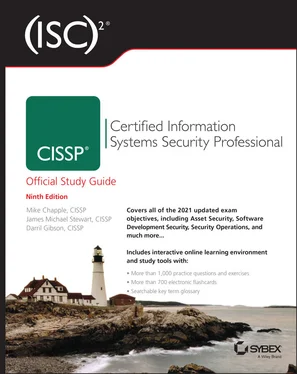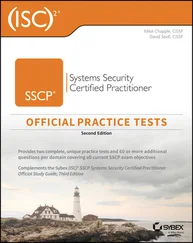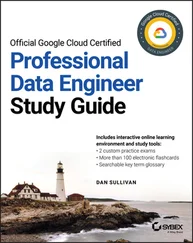Another way in which abstraction applies to security is the introduction of object groups, sometimes called classes, where access controls and operation rights are assigned to groups of objects rather than on a per-object basis. This approach allows security administrators to define and name groups easily (the names are often related to job roles or responsibilities) and helps make the administration of rights and privileges easier (when you add an object to a class, you confer rights and privileges rather than having to manage rights and privileges for each object separately).
Data hiding is exactly what it sounds like: preventing data from being discovered or accessed by a subject by positioning the data in a logical storage compartment that is not accessible or seen by the subject. This means the subject cannot see or access the data, not just that it is unseen. Forms of data hiding include keeping a database from being accessed by unauthorized visitors and restricting a subject at a lower classification level from accessing data at a higher classification level. Preventing an application from accessing hardware directly is also a form of data hiding. Data hiding is often a key element in security controls as well as in programming. Steganography is an example of data hiding (see Chapter 7).
Data hiding is an important characteristic in multilevel secure systems. It ensures that data existing at one level of security is not visible to processes running at different security levels. From a security perspective, data hiding relies on placing objects in security containers that are different from those that subjects occupy to hide object details from those with no need to know about them or means to access them.
The term security through obscurity may seem relevant here. However, that concept is different. Data hiding is the act of intentionally positioning data so that it is not viewable or accessible to an unauthorized subject, whereas security through obscurity is the idea of not informing a subject about an object being present and thus hoping that the subject will not discover the object. In other words, in security through obscurity the subject could access the data if they find it. It is digital hide and seek. Security through obscurity does not actually implement any form of protection. It is instead an attempt to hope something important is not discovered by keeping knowledge of it a secret. An example of security though obscurity is when a programmer is aware of a flaw in their software code, but they release the product anyway hoping that no one discovers the issue and exploits it.
Encryption is the science of hiding the meaning or intent of a communication from unintended recipients. Encryption can take many forms and should be applied to every type of electronic communication and storage. Encryption is discussed at length in Chapters 6and 7.
A security boundary is the line of intersection between any two areas, subnets, or environments that have different security requirements or needs. A security boundary exists between a high-security area and a low-security one, such as between a LAN and the internet. It is important to recognize the security boundaries both on your network and in the physical world. Once you identify a security boundary, you must deploy mechanisms to control the flow of information across that boundary.
Divisions between security areas can take many forms. For example, objects may have different classifications. Each classification defines what functions can be performed by which subjects on which objects. The distinction between classifications is a security boundary.
Security boundaries also exist between the physical environment and the logical environment. To provide logical security, you must provide security mechanisms that are different from those used to provide physical security. Both must be present to provide a complete security structure, and both must be addressed in a security policy. However, they are different and must be assessed as separate elements of a security solution.
Security boundaries, such as a perimeter between a protected area and an unprotected one, should always be clearly defined. It's important to state in a security policy the point at which control ends or begins and to identify that point in both the physical and logical environments. Logical security boundaries are the points where electronic communications interface with devices or services for which your organization is legally responsible. In most cases, that interface is clearly marked, and unauthorized subjects are informed that they do not have access and that attempts to gain access will result in prosecution.
The security perimeter in the physical environment is often a reflection of the security perimeter of the logical environment. In most cases, the area for which the organization is legally responsible determines the reach of a security policy in the physical realm. This can be the walls of an office, the walls of a building, or the fence around a campus. In secured environments, warning signs are posted indicating that unauthorized access is prohibited and that attempts to gain access will be thwarted and result in prosecution.
When transforming a security policy into actual controls, you must consider each environment and security boundary separately. Simply deduce what available security mechanisms would provide the most reasonable, cost-effective, and efficient solution for a specific environment and situation. However, all security mechanisms must be weighed against the value of the objects they are to protect. Deploying countermeasures that cost more than the value of the protected objects is unwarranted.
Evaluate and Apply Security Governance Principles
Security governance is the collection of practices related to supporting, evaluating, defining, and directing the security efforts of an organization. Optimally, security governance is performed by a board of directors, but smaller organizations may simply have the chief executive officer (CEO) or chief information security officer (CISO) perform the activities of security governance. Security governance seeks to compare the security processes and infrastructure used within the organization with knowledge and insight obtained from external sources. This is why a board of directors is often composed of people from a wide range of backgrounds and industries. The board members can bring their varied experience and wisdom to provide guidance for improvement to the organization they are overseeing.
Security governance principles are often closely related to and often intertwined with corporate and IT governance. The goals of these three governance agendas are often the same or interrelated, such as maintaining business processes while striving toward growth and resiliency.
Some aspects of governance are imposed on organizations due to legislative and regulatory compliance needs, whereas others are imposed by industry guidelines or license requirements. All forms of governance, including security governance, must be assessed and verified from time to time. Various requirements for auditing and validation may be present due to government regulations or industry best practices. This is especially problematic when laws in different countries differ or in fact conflict. The organization as a whole should be given the direction, guidance, and tools to provide sufficient oversight and management to address threats and risks, with a focus on eliminating downtime and keeping potential loss or damage to a minimum.
As you can tell, the definitions of security governance are often rather stilted and high level. Ultimately, security governance is the implementation of a security solution and a management method that are tightly interconnected. Security governance directly oversees and gets involved in all levels of security. Security is not and should not be treated as an IT issue only. Instead, security affects every aspect of an organization. Security is a business operations issue. Security is an organizational process, not just something the IT geeks do behind the scenes. Using the term security governance is an attempt to emphasize this point by indicating that security needs to be managed and governed throughout the organization, not just in the IT department.
Читать дальше












